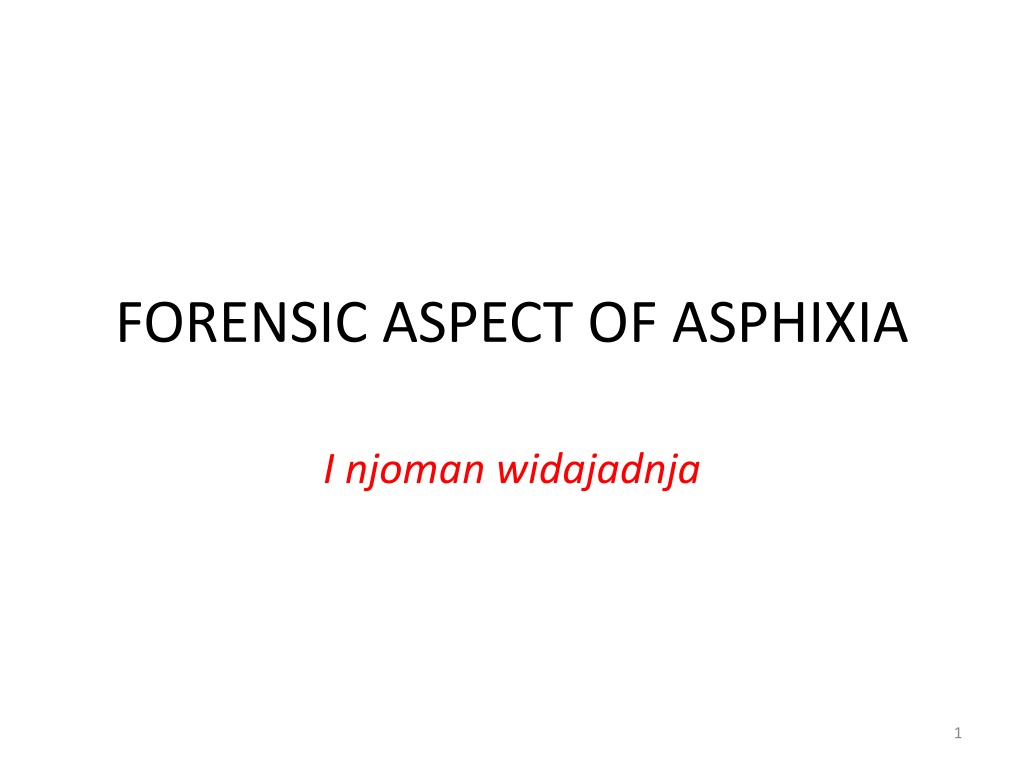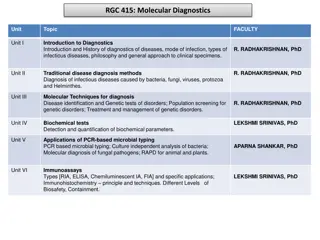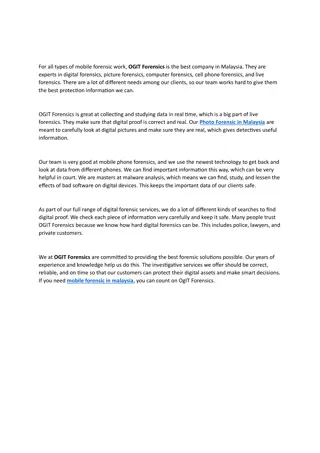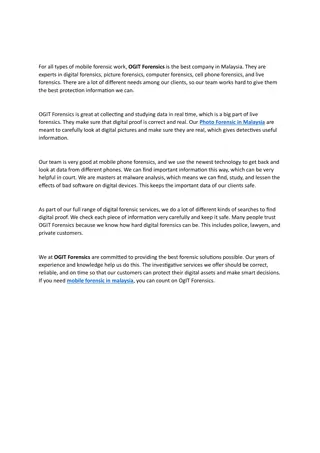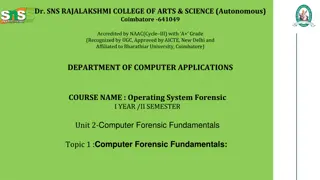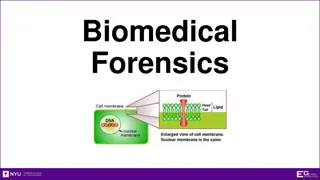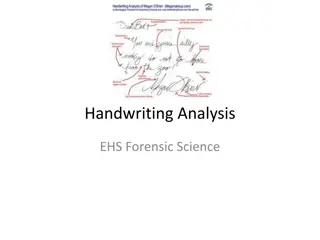FORENSIC ASPECT OF ASPHIXIA
Asphyxia, derived from a Greek word meaning pulseless, refers to a lack of oxygen supply leading to hypoxia in tissues, notably the brain. This comprehensive overview covers the definitions, nature, classification (including mechanical types like strangulation and suffocation), and key results of asphyxia cases. From manual strangulation to smothering and traumatic asphyxia, explore the forensic aspects of various forms of asphyxia in detail.
Download Presentation

Please find below an Image/Link to download the presentation.
The content on the website is provided AS IS for your information and personal use only. It may not be sold, licensed, or shared on other websites without obtaining consent from the author.If you encounter any issues during the download, it is possible that the publisher has removed the file from their server.
You are allowed to download the files provided on this website for personal or commercial use, subject to the condition that they are used lawfully. All files are the property of their respective owners.
The content on the website is provided AS IS for your information and personal use only. It may not be sold, licensed, or shared on other websites without obtaining consent from the author.
E N D
Presentation Transcript
FORENSIC ASPECT OF ASPHIXIA I njoman widajadnja 1
Definition & Nature Definition & Nature Asphyxia is a term which literally derives from a Greek word meaning pulsless which is commonly understood to mean lack of oxygen . -Asphyxia causes generalized hypoxia, which primairly affects the tissues and organs most sensitive to hypoxia first, such as the brain ,hence resulting in cerebral hypoxia & death. 2
Definition: Conditions in which the supply of oxygen to the blood and tissues has been reduced below the normal working level by any interference with respiration. Asphyxia is used as being equal to lack of oxygen or hypoxia , 3
Classification of asphyxia (suffocation = mati lemas) A) Mechanical : 1) Strangulation: this is general term refer to suffocation or attempted suffocation by external compression of the neck either by hands or ligature . Three types of compression are included (hanging, strangling /cekik & throttling(Homicidal / niat membunuh ). 4
Types & forms of suffocation: 2) Smothering (Homicidal ) ex :with Pillow . plastic bag facial occlusion 3) Choking (kesendat). 4) Traumatic asphyxia ( Crush) 5) Blunt force to the throat /pukulan tumpul B) Chemical. C) Sexual . 5
A. Asphyxias Results of manual strangulation using hands Typically, manual strangulation fractures the cornu of the thyroid cartilage Even more common in manual strangulation is hemorrhage of muscles in neck 6
Asphyxias In manual strangulation, fracture of hyoid bone in neck is infrequent, and seen in elderly women who have osteoporosis, which makes fracturing the bone easier 7
Strangling (cekik/jepit/jerat): Externally: The face is either pale or bluish and congested /lebam. The rest of the body is cyanosed. The tongue may be protruded, swollen and bitten /tergigit. Bleeding from ears and nose may be seen. 8
Ligature mark: Shape: as in hanging. Situation: At the level of thyroid cartilage or below. Symmetrical Transverse and complete (this is the usual). 9
Ligature mark: A postmortem swelling of the neck associated with exaggeration of skin folds or any clothes worn around the neck may produce depressed marks. All these look like ligature mark. (Neck dissection can differentiate) ! 10
Strangling Cont The fractures more frequently of the larynx skeleton and less frequent to hyoid bone compared with hanging. Removal of the ligature still leaves behind a Tide mark (jejas) with pallor below (kepucatan)and congestion above. Autopsy : typically reveals hemorrhagic edema of the lungs and an increased amount of secretion in the trachea. 11
Asphyxias Ligature strangulation, whether by hanging , generally results in findingsof a furrow (kerut) in the neck 12
A hanging may induce one or more of the following medical conditions, some leading to death: Closure of carotid arteries causing cerebral ischemia Closure of the jugular veins Induction of carotid reflex, which reduces heartbeat when the pressure in the carotid arteries is high, causing cardiac arrest 13
--Breaking of the neck (cervical fracture) causing traumatic spinal cord injury or even decapitation Closure of the airway - been used to describe a method of suicide/homicidal in which a person applies a ligature to the neck and brings about unconsciousness and then death 14
After death, the body typically shows marks of suspension: bruising and rope marks (memar n jejas tali) on the neck. Moreover, sphincters will relax spontaneously and urine and faeces will be evacuated. Forensic experts may often be able to tell if hanging is suicide or homicide, as each leaves a distinctive ligature mark. One of the hints they use is the hyoid bone. If broken, it often means the person has been murdered by manual choking 15
Findings in cases of death by Findings in cases of death by hanging hanging External findings : 1. The marks : the most external finding are ligature or strangulation marks, the marks are area of dried skin on the neck where it was compressed by the ligature, mostly the skin takes yellow-brown to brown-red color. 2. Petechial hemorrhage . 3.Saliva : Traces of saliva may be present at the corner of the mouth and this very important because these trace makes it possible to know the situation in which the body was found at the time that the person was hanged . 4.Bleeding : from nose and external auditory canal. 5.Discharges : Feces,Urine,Semen. 16
Internal findings Internal strangulation marks found in subcutaneous soft tissue. Bleeding into lower attachments of the sternocliedomastoid muscles. Fracture of the laryngeal skeleton and the hyiod bone . Simon s bleeding : hemorrhages into the outer layer of intervertebral discs of lumbar region. 17
Throttling (cekik): definition- throttling refer to the compression of the neck with one or both hand The sign of congestion are often extreme Typically but not always strangulation marks are found caused by imprint(himpitan) of the finger tip exerting pressure The occurrence of fatal reflexes must always be carefully considered in case of throttling (tanda-2 reflek kematian +) There is considerable hemorrhage into the soft tissue of the neck and hemorrhage are present in the base of the tongue Fracture of the hyoid bone and\or laryngeal skeleton can occur 18
Smothering (menindas sampai mati lemas): Is blockage of external air passages by (fabric, sheet, solid material) Groups of risk are elderly , infants A part from classical signs of asphyxia such as petechiea may appear and there is usually a lack of objective finding. Plastic bag suffocation can be rapid and symptomless depending on how it is done. The death in plastic bag facial occlusion is some rapid cardio inhibitory mode rather than purely hypoxic process. 19
Choking (tersendek) Refer to the blockage of the internal air way( glottis or trachea) by foreign bodies . Almost Accidental Death can be of purely hypoxic origin from occlusion of airway with characteristic signs of congestion , cyanosis & petechiae. The groups most at risk are : Children, old people, mentally disorder, drunk,Greedy Eaters ,Drugged 20
Choking Caused by mechanical occlusion of the air passage from inside. Mechanism of death: Asphyxia: due to either complete occlusion of air passage, or partial occlusion that is completed by spasm, edema and mucus secretion. 21
strangling throttling Smothering Choking Neck compression where the instrument used, tightened actively either by hand or by another object neck compression with one or both hands. blockage of external air passages by (fabric, sheet, solid material) the blockage of the internal air way( glottis or trachea) by foreign bodies def imprint of the finger tip exerting pressure. Not always found fatal reflexes must always +ve in case of throttling. congestion in the skin and the mucous membrane of the face are often more marked than in hanging the mark of strangling has an even depth and runs around the neck in complete circle including the posterior aspect of the neck petechiea may appear. characteristic signs of congestion , cyanosis & petechiae. signs fractures of the larynx skeleton Tide mark with pallor below and congestion above. hemorrhage into the soft tissue of the neck and in the base of the tongue Fracture of the hyoid bone and\or laryngeal skeleton can occur Plastic bag suffocation can be rapid and symptomless depending on how it is done. +ve lack of objective finding. Risk groups: elderly , infants The death in plastic bag facial occlusion is some rapid cardio inhibitory mode rather than purely hypoxic process. Almost Accidental Risk groups: Children, old people, mentally disorder, drunk,Greedy Eaters ,Drugged it caused by: ischemia (by compression on carotid art) and obstruction of breathing (by compression of the trachea or the larynx). Autopsy : hemorrhagic edema of the lungs and an increased secretions in the trachea. notes 24
Crush asphyxia traumatic asphyxia or crush asphyxia is usually used to describe compressive asphyxia resulting from being crushed or pinned under a large weight or force Ex..collapsing trenches, panic in crowds, car- jack while repairing from below, even anacondas and pythons These case tend to exhibit gross congestion,cyanosis,and petechiae of the face, neck and shoulder with bleeding from the ear and the nose 25
B. Chemical Trauma Ethyl alcohol, (ethanol) active ingredient in beer, wine and liquor is a contributory factor in 50% of traumatic deaths Alcohol is a depressant: it slows reactions and communications from the brain and spinal cord neurons Person under influence of alcohol breathes slower and slower until lack of oxygen causes death Around a .30 gram percent of blood alcohol, person goes into coma 26
Chemical Trauma Carbon Monoxide (CO) is an odorless, colorless, explosive gas Deaths due to CO may be accidental, suicidal or homicidal CO kills by asphyxiation: binds to hemoglobin 300 times more than oxygen and cuts off oxygen to brain 27
Chemical Trauma Cyanide is generally available as sodium or potassium salt Has a distinct odor like almonds Up to 50% of the population can t smell cyanide Forensic Pathologists should be able to smell cyanide, especially in cases of suspected of suicide by cyanide. 28
The general changes caused by asphyxia: 1)cyanosis:This is the direct result of oxygen depletion , oxyhaemoglobin becoming replaced by reduced haemoglobin. The dark colour of the blood as seen through the skin imparts a bluish tinge to the face & other parts of the body. Some degree of periphral cyanosis is common as to be almost routine in dead bodies- it does not imply asphyxia. 29
2)oedema:In asphyxia, the venous return from the head and neck may be abstructed either directly, from pressure on the neck or indirectly as a result of an increase in pressure within the chest which stops the blood entering the heart so easily. This causes venous engorgement (congestion) of the face, neck and also of the lungs. The increased hydrostatic pressure within the veins also causes fluid to leak out of the smaller veins into the soft tissues. Soft tissue swelling may also affect the eye sockets, causing the eyes to bulge forwards 30
It is a form of violent asphyxia in which death results from submersion of mouth and nostrils of a living person under water Classification (types) of drowning: 1- Typical (wet) drowning: 2- Dry drowning. 3- Secondary drowning (Near-drowning). 31
Physiopathological changes: In fresh water hypervolemia hypoxia and potassium excess. In salt water pulmonary edema hypovolemia and circulatory shock. 32
Dry drowning: Water in the larynx laryngeal spasm asphyxia Near-drowning (2nd drowning syndrome): 33
External appearances 1. Signs of immersion (menyelam): These are found in any body found dead in water (whatever the cause of death). Coolness of the body. Goose-skin the skin is wrinkled (kisut). Washerwoman-skin: the skin is sodden (lembab). Peeling (kelupas) of the epidermis in the form of gloves and stockings. Hypostasis 34
Internal appearances Voluminous lungs with indentation marks of ribs on their lateral surfaces. Respiratory passages contain froth (having the same characters of that found externally at the mouth and nostrils), foreign material ( weeds /rumput, mud, sand,.). 35
Diatoms: These are microscopic, unicellular algae, found in fresh as well as salt water. When a live person is drowned in water, they penetrate his alveolar membrane and pass with the circulation to distant organs. But when a dead body is thrown into water, the absence of beating heart prevents circulation of diatoms to distant organs. 36
Asphyxias Diatoms assist in providing clues to determine time and place of drowning Diatoms are small unicellular one celled organisms found in salt or fresh water Contain silica, and resist degradation During late stages of drowning, diatoms in aspirated water are circulated by heart to organs, including bone marrow Not normally found in bone marrow, diatoms can assist especially if body is severely decomposed or skeletonized 37
some of the plant material in the water was aspirated into a bronchus. 38
How to know that death was due to drowning: 1-Froth (busa) at mouth and nostrils: fine, white, abundant / berlebihan. 2.Cadaveric spasm on weeds, mud or sand. 3.Lungs: voluminous, edematous with indentation marks of the ribs. 4.Froth in the air passages. 5. Diatoms in the tissues. 40
Stages of asphyxia 1- Stage of dyspnea: Cyanosis, rapid deep breathing with acting extraordinary muscles of respiration. Rapid pulse and high blood pressure. 2- Stage of convulsions: Cyanosis becomes deeper. Breathing becomes difficult and spasmodic. Congestion and edema of lungs and other organs. Petechial hemorrhages in skin, lungs, heart and brain. Convulsions occur. 41
3- Stage of apnea (respiratory paralysis): Unconsciousness occurs. Breathing becomes shallow, infrequent and gasping, then apnea occurs. Pulse becomes weak and BP is reduced. 42
External Postmortem (PM) picture 1- Petechial hemorrhages: Sites of formation: Mechanism of formation 2- Postmortem hypostasis is well-developed and dark in color 3- Cyanosis 4- Rigor mortis is rapid / lebam mayat 5- Putrefaction is rapid /pembusukan. 43
Internal Postmortem (PM) picture Petechial hemorrhages under the pleura and pericardium and in the internal organs. Congestion and edema of the viscera ( except the spleen). The blood is dark in color and more fluidly. The right heart and great veins are engorged (penuh) with blood. 44
cyanosis:This is the direct result of oxygen depletion , oxyhaemoglobin replaced by reduced haemoglobin. The dark colour of the blood as seen through the skin imparts a bluish tinge to the face & other parts of the body. Some degree of periphral cyanosis is common as to be almost routine in dead bodies- it does not imply asphyxia. becoming 45
oedema:In asphyxia, the venous return from the head and neck may be abstructed either directly, from pressure on the neck or indirectly as a result of an increase in pressure within the chest which stops the blood entering the heart so easily. This causes venous engorgement (congestion) of the face, neck and also of the lungs. The increased hydrostatic pressure within the veins also causes fluid to leak out of the smaller veins into the soft tissues. Soft tissue swelling may also affect the eye sockets, causing the eyes to bulge forwards 46
Mechanism of death: 1. Cerebral anoxia 2. Cerebral congestion. 3. Asphyxia: 4. Reflex vagal inhibition 47
